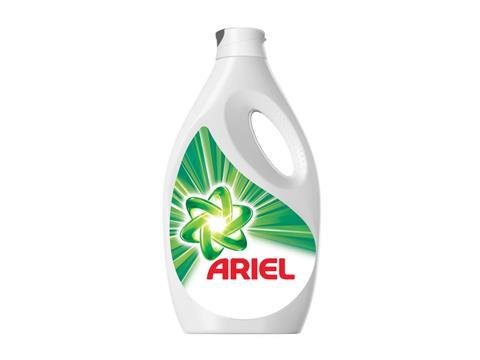
We interviewed P&G to find out more about its PCR-containing Ariel pack, which is a finalist in the 'Driving the Circular Economy' category of our 2020 Sustainability Awards.
Congratulations on being selected by the international judging panel as a Sustainability Awards 2020 finalist! Could you please introduce your successful entry and what’s innovative about it?
P&G is driving a circular economy for recycled plastics in Europe using our five-pillar model: design for recycling, collection, consumer engagement, innovation in sorting/recycling, and creating end markets.
This entry builds on the creation of significant end markets through the use of recycled polyethylene (rHDPE) resin in Ariel liquid detergent bottles. Using recycled resin up to 50% in HDPE bottles is considered as a major waste reduction strategy.
P&G has entered a five-year partnership agreement with Viridor that foresees recycling and reprocessing high-density polyethylene (HDPE) plastic, for re-use in Ariel laundry detergent bottles.
The high-density recycled polyethylene (rHDPE) resin will enable Ariel to bring to life the commitment of reaching up to 50% recycled content in its liquid bottles as of 2020. The agreement between P&G and Viridor, one of our plastic recyclers, will save the equivalent of 200 million bottles of virgin plastic over five years.
We believe that pledging to increase the amount of PCR in packages is good and signing long-term agreements to recycle and re-use plastic in laundry detergent bottles is even better. By developing and fostering end-markets, we help to ensure there is demand for recycled materials which would otherwise be destined for landfill. This helps to unleash the circular economy.
What are the environmental challenges in packaging that your entry addresses, and what impact do you hope it will make?
The challenge in using PCR in our bottles is to maintain both package and product performance. We have accomplished this by developing an in-depth fundamental understanding of our work and collaboration with supply chain partners. Our packages will continue to meet the highest quality standards while using recycled resin.
P&G’s Ambition 2030 goals aim to enable and inspire positive impacts on the environment and society through brands, the supply chain, and employees, while creating value for the company and consumers. It’s P&G’s ambition that 100% of our packaging will be recyclable or reusable by 2030. Additionally, we aim to reduce the use of virgin petroleum-based plastics by 50%.
P&G enables PCR use on a broader scale. P&G is increasing the amount of PCR up to 50% in our Ariel laundry detergent bottles in Europe. P&G expects to increase PCR even further over time and is taking significant steps to increase the amount of recycled material used. Thanks to a new circular economy partnership between Viridor and P&G, Ariel plans to save equivalent of 200 million bottles virgin plastic over five years.
We are optimistic that through partnerships and with the power of leading brands such as Ariel we can progress addressing the environmental challenges of our planet.
This initiative stimulates a circular economy and hopefully motivates consumers to choose a sustainable solution, a package containing recycled resin. The introduction of increasing the amount of PCR up to 50% is enabling consumers to make more conscious environmental choices.
Innovations like this provide consumers with a sustainable choice without compromising on package or product performance.
I’d like to ask you about the broader picture beyond your successful entry. ‘Sustainability’ in packaging is multi-dimensional – both in terms of objectives and challenges. Could you comment on the most important roadblocks you identify from your position in the value chain, and the kinds of solutions you would like to see addressing them (e.g. areas of technological innovation, collaboration, regulation)?
Identifying a compatible PCR grade for our detergent requires a lot of screening and qualifications work. It would be beneficial if the industry would develop PCR grades for detergent/cosmetics. Something similar like you have now for PET grade for food applications.
These future grades could enable faster selection and hence qualification. Specific grades for detergent would probably also enable faster clearances for substances of high concern.



















